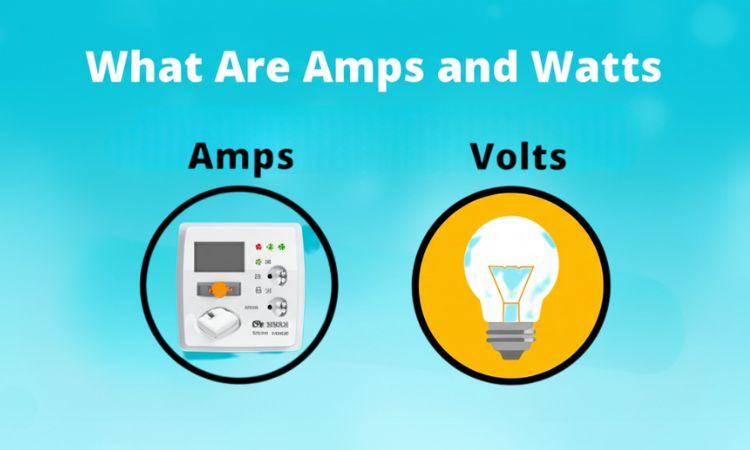Amps to Watts Conversion and Calculation
Electricity is a fundamental aspect of modern life, and knowing how it works helps optimize energy use. Understanding the relationship between electrical current and power is essential for various applications, from household electronics to industrial equipment.
If you've ever wondered how to convert amps to watts, you've come to the right place. This article will walk you through the process, explain the formulas, and provide a helpful conversion chart. By the end, you can calculate power from electrical current with confidence.
What Are Amps and Watts?
To understand electrical power, you must grasp three key concepts: volts, amps, and watts. Each plays a distinct role in measuring electricity and determining power consumption.
Amps (A):
Amps measure the flow of electricity, similar to how cars move along a highway. The more cars there are on the road, the stronger the flow. In the same way, a higher number of amps means a stronger electric current.
Volts (V):
Volts represent the force that pushes electricity through a circuit, just like the speed limit determines how fast cars can travel. Higher voltage means a stronger push, allowing electricity to flow more efficiently.
Watts (W):
Watts measure the total power output, which is a combination of both current (amps) and force (volts). In the highway analogy, watts represent the total movement of traffic, more cars moving at higher speeds means greater energy being used or transmitted.
The relationship between these units is simple: multiplying amps by volts gives you watts. Since watts depend on both current and voltage, there isn’t a fixed number of amps in a watt without knowing the voltage. Understanding this relationship helps optimize energy usage, ensuring electrical devices operate efficiently and preventing power wastage.


How Do You Convert Amps to Watts?
Now that you understand amps, volts, and watts, let’s see how to convert amps to watts. This conversion helps you calculate how much power an electrical device uses. Here's the formula:
DC Amps to Watts Calculation
For direct current (DC) circuits, the calculation is straightforward using:
Watts = Amps × Volts
Example: If you have a 10A device operating at 12V. The power consumed is:
10A x 12V = 120W
DC power is commonly used in batteries, solar generator setups, and electronic circuits, where a steady voltage is required.
AC Single Phase Amps to Watts Calculation
For single-phase alternating current (AC), the formula is:
P(W) = PF × I(A) × V(V)
Power factor (PF) varies by device type.
Example: A 10A appliance at 120V with a PF of 0.8 consumes:
0.8 x 10A x 120V = 960W
AC power is used in homes and commercial buildings, where voltage fluctuates periodically.
AC Three Phase Amps to Watts Calculation
For three-phase AC circuits, there are two standard calculation methods based on voltage type:
1. Calculation with Line-to-Line Voltage
The power P in watts (W) is calculated by multiplying the square root of 3, the power factor (PF), the phase current I in amps (A), and the line-to-line RMS voltage VL-L in volts (V):
| P(W) = √3 × PF × I (A) × VL-L(V) |
|---|
Example: A 10A motor at 400V with a PF of 0.9 consumes:
1.732 × 10A × 400V × 0.9 = 6.235W
2. Calculation with Line-to-Neutral Voltage
The power P in watts (W) is calculated by multiplying 3, the power factor (PF), the phase current I in amps (A), and the line-to-neutral RMS voltage VL−N in volts (V):
| P(W) = 3 × PF × I(A) × VL-N(V) |
|---|
Example: A 10A motor at 230V with a PF of 0.9 consumes:
3 × 10A × 230V × 0.9 = 6.210W
Three-phase systems are widely used in industrial applications and large-scale power distribution due to their efficiency and reduced energy losses.
Typical Power Factor Values for Common Devices
Here’s a quick look at typical power factor values for common household appliances:
| Device | Typical power factor |
|---|---|
| Resistive load | 1 |
| Fluorescent lamp | 0.95 |
| Incandescent lamp | 1 |
| Resistive oven | 1 |
| Synchronous motor | 0.9 |
| Induction motor full load | 0.85 |
| Induction motor no load | 0.35 |
Amps to Watts Conversion Chart
Below is a conversion chart that helps convert amps to watts at 240 V:
| Current (A) | Voltage (V) | Power (W) |
|---|---|---|
| 0.1 A | 240 V | 24 W |
| 0.2 A | 240 V | 48 W |
| 0.3 A | 240 V | 72 W |
| 0.4 A | 240 V | 96 W |
| 0.5 A | 240 V | 120 W |
| 0.6 A | 240 V | 144 W |
| 0.7 A | 240 V | 168 W |
| 0.8 A | 240 V | 192 W |
| 0.9 A | 240 V | 216 W |
| 1 A | 240 V | 240 W |
| 2 A | 240 V | 480 W |
| 3 A | 240 V | 720 W |
| 4 A | 240 V | 960 W |
| 5 A | 240 V | 1200 W |
| 6 A | 240 V | 1440 W |
| 7 A | 240 V | 1680 W |
| 8 A | 240 V | 1920 W |
| 9 A | 240 V | 2160 W |
| 10 A | 240 V | 2400 W |
Practical Applications of Amps to Watts Conversion
Knowing how to change amps to watts is valuable for everything from home appliances to managing a solar power station efficiently:
Home appliances
By converting amps to watts, you can select appliances that are compatible with your home's electrical capacity. This ensures efficient energy use, prevents circuit overloads, and promotes the proper functioning of your appliances.
Power setups
Calculating amps to watts helps design the right power configurations for your needs. By matching your device's energy requirements with the output of your power setup, such as the EcoFlow DELTA Pro 3 Portable Power Station, you can ensure a stable and reliable power supply for your devices.
Industrial equipment
Managing heavy-duty machinery safely requires knowing its power consumption. Converting amps to watts ensures proper power distribution, prevents electrical overloads, and keeps industrial equipment running efficiently within safe limits.
Electrical troubleshooting
Learning how to figure out watts from amps helps diagnose power issues. This knowledge allows you to detect faulty components, and choose the right circuit protection for a stable power supply.
Voltage conversion needs
When working with different voltage levels, converting amps to watts helps determine the power required for a device. In such cases, you may also need to convert volts to watts to accurately assess power consumption and maintain system efficiency.


Conclusion
In conclusion, understanding how to convert amps to watts is a crucial skill for efficiently managing energy in various settings, from home appliances to industrial machinery and off-grid power setups. It helps prevent overloads, ensures safe operation, and allows you to make smart decisions for reliable, cost-effective power usage.
FAQs
Why do I need to convert amps to watts?
Converting amps to watts is important because it helps you understand how much power an electrical device is using. By knowing the power consumption in watts, you can manage energy more efficiently, avoid overloading circuits, and ensure that your electrical system runs smoothly without wasting energy.
How many watts in 1 amp?
There are 120 watts in 1 amp at 120 volts. This is calculated using the formula: Watts = Amps × Volts (1A × 120V = 120W).